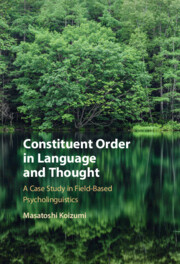Book contents
- Constituent Order in Language and Thought
- Constituent Order in Language and Thought
- Copyright page
- Dedication
- Contents
- Figures
- Tables
- Preface
- Abbreviations
- Chapter 1 Introduction
- Chapter 2 Kaqchikel Mayan
- Chapter 3 Word Order Preference in Sentence Comprehension I: Behavioral Studies
- Chapter 4 Word Order Preference in Sentence Comprehension II: fMRI Studies
- Chapter 5 Word Order Preference in Sentence Comprehension III: ERP Studies without Context
- Chapter 6 Word Order Preference in Sentence Comprehension IV: ERP Studies with Context
- Chapter 7 Basic Word Order in Language and Natural Order of Thought
- Chapter 8 Constituent Order Preference in Event Representation
- Chapter 9 Word Order Preference in Sentence Production I: Production Frequency
- Chapter 10 Word Order Preference in Sentence Production II: Time Course and Cognitive Load
- Chapter 11 Grammatical Processing and Event Apprehension
- Chapter 12 Syntactic Structure of Kaqchikel Revisited
- Chapter 13 Syntax and Processing Load
- Chapter 14 Concluding Remarks
- Book part
- References
- Index
Chapter 5 - Word Order Preference in Sentence Comprehension III: ERP Studies without Context
Published online by Cambridge University Press: 19 January 2023
- Constituent Order in Language and Thought
- Constituent Order in Language and Thought
- Copyright page
- Dedication
- Contents
- Figures
- Tables
- Preface
- Abbreviations
- Chapter 1 Introduction
- Chapter 2 Kaqchikel Mayan
- Chapter 3 Word Order Preference in Sentence Comprehension I: Behavioral Studies
- Chapter 4 Word Order Preference in Sentence Comprehension II: fMRI Studies
- Chapter 5 Word Order Preference in Sentence Comprehension III: ERP Studies without Context
- Chapter 6 Word Order Preference in Sentence Comprehension IV: ERP Studies with Context
- Chapter 7 Basic Word Order in Language and Natural Order of Thought
- Chapter 8 Constituent Order Preference in Event Representation
- Chapter 9 Word Order Preference in Sentence Production I: Production Frequency
- Chapter 10 Word Order Preference in Sentence Production II: Time Course and Cognitive Load
- Chapter 11 Grammatical Processing and Event Apprehension
- Chapter 12 Syntactic Structure of Kaqchikel Revisited
- Chapter 13 Syntax and Processing Load
- Chapter 14 Concluding Remarks
- Book part
- References
- Index
Summary
Chapter 5 investigates the time course of the processing of Kaqchikel sentences with alternative word orders. A sentence–picture matching task was employed in an experiment measuring event-related potentials (ERPs). In this experiment, a Kaqchikel sentence was presented aurally through a headset; afterwards, a picture was presented in the center of a screen, either matching the event described by the preceding sentence or not. Upon seeing the picture, the participants were asked to judge whether the picture was congruent with the sentence. The target sentences used in this experiment were all transitive, with thematically reversible agents and patients, arranged into four word orders: VOS, VSO, SVO, and OVS. A late positive ERP component called P600 was used to examine processing loads, as P600 has been found to be elicited by sentences with a filler-gap dependency, reflecting an increased syntactic processing cost. The results of the two experiments demonstrated that SVO elicited a greater positivity (P600) than VOS, and that VSO elicited a similar posterior positivity, relative to VOS. This range of properties follows naturally from the combination of the IGV and the syntactic structures of Kaqchikel transitive sentences given in Chapter 2.
Keywords
- Type
- Chapter
- Information
- Constituent Order in Language and ThoughtA Case Study in Field-Based Psycholinguistics, pp. 49 - 60Publisher: Cambridge University PressPrint publication year: 2023

